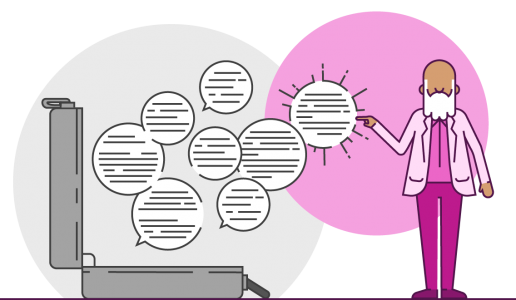Do your sales presentations sound like corporate mush? Take it from those who live and breathe presentations, these unhealthy habits aren’t doing your decks any good!
Don’t write by committee
The saying goes ‘too many cooks spoil the broth’ and the same applies to presentations. Writing by committee can make the language in your deck stagnant and impersonal, as well as creating a bloated and unfocused deck. The more people trying to get their ideas onto the slide, the more text you’ll add just to keep everyone satisfied, and lots of text is the death of a good presentation.
Instead of getting everyone and their dog to pitch in on the deck, create a small, dedicated team of subject matter experts who can develop a compelling, informative, and focused presentation.
Be brave with your story
In any business, playing it safe isn’t going to get you anywhere. This is especially true with presentations. If you think of a typical corporate presentation, you’re probably imagining boring slides with a bunch of bullet points and some crowded data on it for good measure. If you’re lucky, you might even get a sprinkling of pretty but irrelevant pictures.
What if I told you you’re allowed to think outside the box for presentations as well as business ideas?
Everyone loves a good story, that’s why Netflix has become the national pastime. You can take advantage of this when you’re crafting a presentation. By using effective storytelling, you can weave a thread throughout your content and keep your audience’s attention (even when you’re going through the boring bits).
For example, if you are providing a service that takes your client from the beginning to the end of a process, you could use the metaphor of planting, tending and growing a garden for the different stages of the project.
Say you’re trying to convince the C-Suite of your company to change a key procedure in your work flow. You’ve probably been pushed back quite a lot with the idea if it’s not completely broken, then why bother messing with it at all? This is where the storytelling comes in. Paint a picture of just how dangerous inertia really is. If we don’t change now, we’ll be stuck behind in the mud as all of our competitors race by us and take our customers with them. Scary right? By using a narrative, it allows your audience to really feel how change (or lack of change in this case) could affect them, and why they should listen to your solution.
Another top tip, if you’re pitching to a new client, instead of starting the presentation with your org chart and company credentials, why not start with what’s going to prevent your prospect reaching their goals this year? This makes them the main character, not you and your company, which is going to help them pay attention and see how your solution is the right fit for them.
Storytelling can also be really useful for internal training decks, as crafting a story that puts your employee in the centre will make them much more engaged with the content and more likely to remember the message. This could be through something like scenario-based training which puts your employee at the heart of the action and gives them insight into a really situation they might have to contend with in their role.
If you want to learn more about Storytelling in presentations, take a look at this post.
Reuse slides intelligently
You may think you can save time when creating a deck by delving into the archives and pulling out old slides that kind of cover what you want to talk about. Even if they’re not perfect, they’ll do, right? Wrong.
Reusing slides can lead to problems as it means you either haven’t thought hard enough about the overall message of your presentation, or you’re compromising that message for the sake of saving a few minutes. Without a clear and consistent string of thought running through your corporate presentation, your audience may be left confused after you’ve finished presenting, and all they’ll remember is ‘blah blah blah’.
Another pitfall with reusing slides is that even if they do mostly match what you want to say, even a tiny little fix can take a long time. If you have multiple layers or animation to control the flow of your information, getting to the right section can be tough. Then once you’ve edited that section you might find that your grouping has broken, or your animations are all in the wrong order. Fixing this ends up taking even more time than creating a new slide from scratch, with a far less effective outcome. Don’t even get me started on the design implications of combining slides from different decks – no one wants a franken-station.
Now, I’m not saying that you can never reuse your slides. Some things are really important to keep consistent throughout all your decks, like your product and service offerings, as you want to build recognition and understanding on these topics, and reusing layouts can help keep your content consistent across presentation materials. Just make sure that the next time you’re diving into old decks you ask yourself first, is this really conveying the message I want to get across?
Know when you don’t need a corporate presentation
You might think it’s a bit strange that we, as a presentation design company, are telling you that you don’t always need a deck, but it’s true! Not every single meeting requires a 30-slide presentation (thank goodness!).
For example, in something like an initial pitch meeting, you might actually be better off with an ‘elevator pitch’, which is a quick 5 minute talk without any kind of deck to back you up. If you’ve only got a limited amount of time, you might not want to be fumbling over slides and trying to work out how to use the clicker.
Another situation where you might want to ditch the deck is when you’re in a one-on-one conversation. Presenting an all-singing, all-dancing deck to one person might be a slight overkill and can feel very awkward. Try something like a whiteboard or a flip chart so you can write things down on-the-fly and involve your (small) audience more as you’re talking. If you’d like to follow up with some polished up material, you could always send an information pack after your meeting has taken place, maybe in the form of an interactive PDF.
If you’d like to learn more about crafting engaging corporate presentations yourself, sign up for our free masterclasses, which are run on Thursdays at 4pm UK time. If you’re wanting to create an effective deck but you’d like some help from the experts, reach out to us.
Leave a comment




Can you send this to every presenter on the planet who works for a large organization? I always say the worst thing you can do to design your presentation is to open PowerPoint. thanks for this